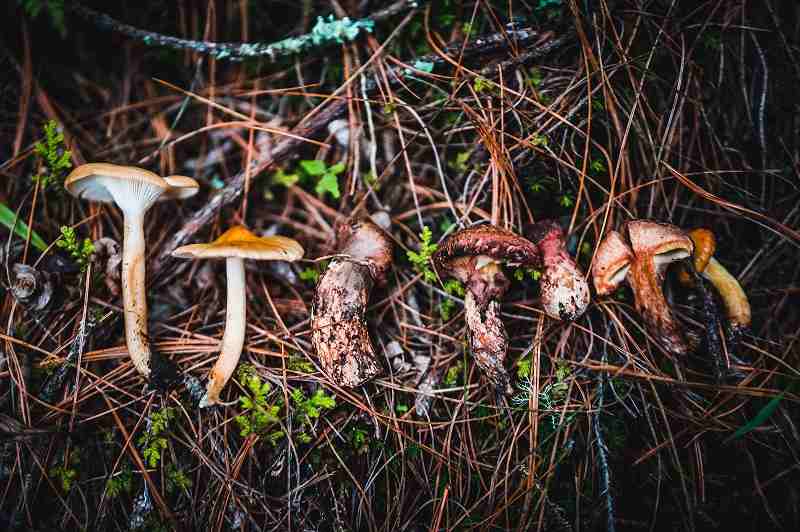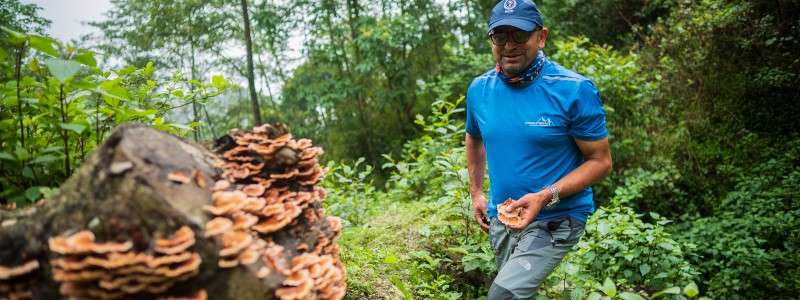In shadow of giant mountains, they explore vital world of mushrooms

Infundibulicybe gibba and Suillus phyllopictus collected during a mushroom foray in Phakding, Nepal.
11:40 JST, September 19, 2022
As he treks beneath Nepal’s towering peaks, Shiva Devkota looks down – at Himalayan lichens and mushrooms and an often-overlooked yellow and orange world beneath his feet.
Devkota, Nepal’s leading mycologist, is documenting biodiversity in the region that’s home to Mount Everest, much of it potentially threatened by climate change. He led a team of trekkers that included mycologists, or mushroom scientists, on an eco-trek this summer through Sagarmatha National Park and its environs in Nepal’s Solukhumbu District.
“The forest here is covered with life, but this is one of the most understudied parts of the world. There’s no books about it here, it’s kind of a black box,” said Britt Bunyard, a mycologist and editor in chief of the journal Fungi who was part of this summer’s trek. Fungi “do everything for the biodiversity of the planet. They are partners for pretty much all plants.”

Mycologist Shiva Devkota with a tree stump brimming with Stereum sp., a wood-decaying fungus, south of Nepal’s Sagarmatha National Park in June. Devkota and others trekked to Everest Base Camp to observe biodiversity in the Everest region.
Travel barriers – and their costs – have thwarted scientific study in the Everest region, which makes Devkota’s work all the more essential. Over a 15-day trek, Devkota and his colleagues identified over 150 distinct mushroom species in the climate-vulnerable region, which is warming 0.3 to 0.7 degrees faster than the rest of the planet as the mountains’ ice cover melts.
Without these fungi, ecosystems cannot survive. “If you killed all the mycological fungi on the planet, all the trees would die,” Thomas Roehl, a mycologist on the trek, put it bluntly. “So fungi are responsible for the life of everyone on the surface of the world.”
Fungi provide nutrient-cycling services to plant and tree species, sustaining the organisms that provide oxygen for human and animal life. Almost all trees rely on one, or many, fungi species, which absorb and transfer nitrogen, phosphorus, water and other minerals through mycelium – fungal – networks. In exchange, fungi receive carbon produced by the tree or plant in photosynthesis.
“Mushrooms don’t exist in isolation. In fact, they play an enormous role in resource-sharing and survival of almost every plant,” said Rick Silber, executive director of International Mountain Trekking (IMT), who organized this year’s trek with Sonam Jangbu Sherpa, the lead guide on the fungi trek. The trekkers included mycologists and nonscientists with an interest in mushrooms.
With a permit from the Nepali government for their work, mycologists on the trek documented what they believe are several rare, or potentially newly discovered, mushrooms, including Amanita innatifibrilla, only once recorded in China, and Tremella salmonea, a fungi first documented in China in 2019. They also found Amanita tullossiana, a new species discovered in 2018 in the northwest Himalayas of Uttarakhand, India.
The region’s sheer altitude gradient allowed researchers to study mushrooms in a 9,842-foot range, mapping specimens in the forests below Lukla up to alpine meadows far above the tree line. The highest mushroom discovered was a puffball found at 17,037 feet, just below Everest Base Camp at 17,598 feet.
“There is this amazing biodiversity in Nepal – uniquely true because of the extraordinary altitude gradient – within a short band, the terrain goes from [6,000 to] 7,000 feet to the highest point on Earth,” Silber said.
Because of their ability to grow at high altitudes, mushrooms are a food source for people in the Everest region. Locals gather four edible species of mushrooms, which are dried and stored for the long winter seasons when fresh vegetables are unavailable.
Devkota’s documentation of the region’s mushrooms could equip locals with greater knowledge of species safe for consumption, especially as mushroom poisonings occur in other parts of Nepal.
Fungi and lichen patterns can also be indicators of global warming trends. Mushroom growth is believed to be linked to annual snowfall levels, and lichens are indicative of glacier melt; at higher altitudes on the Khumbu Glacier, researchers observed no lichens on rocks recently exposed as the ice quickly recedes.
The high altitude region is acutely vulnerable to climate change – at least one-third of the glaciers and possibly two-thirds are expected to be gone by the end of the century, according to a 2019 report by the International Center for Integrated Mountain Development.
Silber said there is an urgent need for further scientific research, not just tourism, in the Khumbu.
“This place is warming three times faster than the rest of the planet, the water here provides for 20 percent of the population,” he added, referring to the 2 billion people who live downstream of the Himalayan glaciers and rely on their water resources. “You can’t even begin to talk about solutions or mitigation unless you understand the region’s science,” Silber said.
Understanding how mushrooms react to climate change in the Himalayas, however, will take time, and Devkota is only starting the work in officially documenting the region’s fungi species.
“We cannot generalize the impact of climate change while working in a short time frame,” Devkota said. “For scientific data, we need to work season by season.”





